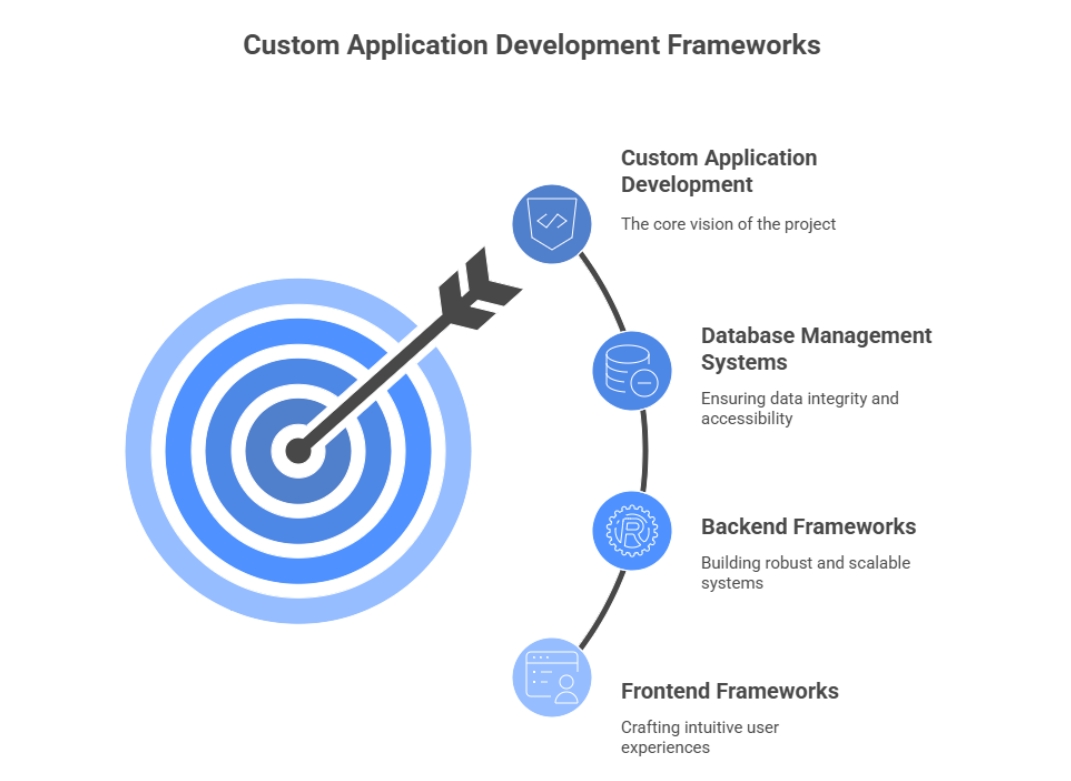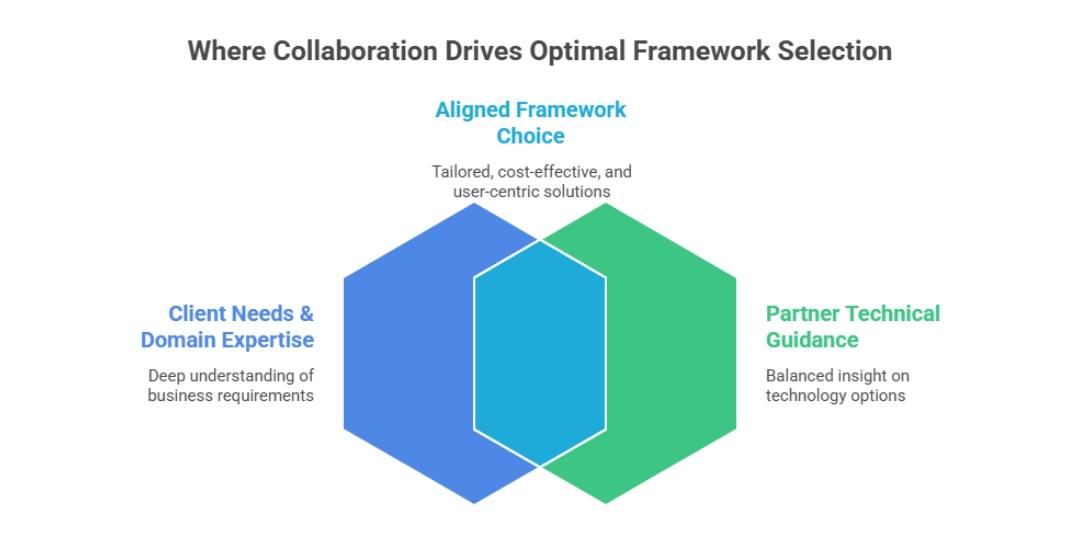The Hidden Costs of Off-the-Shelf: Why Custom Application Development is a Superior Investment

The Blueprint for Your Digital Tomorrow: Why Frameworks Matter
A solid foundation is the first step towards a successful custom digital application development service. Frameworks act as the structural framework for your system, affecting its scalability, ease of maintenance, and alignment with your company objectives. All too frequently, companies rush into developing on unreliable or unsuitable frameworks and pay the hidden price in the form of technical debt that impedes future innovation or the need to replatform.
At Techmango, By supporting purpose-built experiences, facilitating agility, and setting up your system to evolve without interruption, investing in strong frameworks now is an investment in your digital future.
Understanding the Role of Frameworks in Custom Software
Fundamentally, a framework gives your codebase organization. It outlines the structure of components, the flow of requests, and the management of dependencies. Using well-established frameworks lowers development risk because teams don’t have to start from scratch, use pre-built libraries, and follow security, testing, and performance best practices.
At techmango, our frameworks are strategic enhancers rather than merely tools in the context of developing custom applications. They determine how developers work together, how fast features are developed, and how readily the system can be modified to meet new needs. The first decision establishes the standard for innovation speed, flexibility, and maintainability.
The Importance of a Solid Foundation for Scalability and Maintainability
Without a sound foundation, even well-implemented features become brittle over time. Scalability becomes unstable, code starts to clog, and performance deteriorates. When your platform needs to support ten, a hundred, or a thousand times more users, or when you need to pivot features to match new user stories, a poorly structured codebase collapses under change.
With strong frameworks, code is modular. Services are loosely coupled. Testing is automated. Developer onboarding becomes easier. The benefits extend beyond engineering: product teams can innovate faster, QA can validate features reliably, and leadership gains confidence that your platform can support multi-million-dollar initiatives without breakdowns.
Key Pillars of Custom Application Development Frameworks
To understand how frameworks contribute strategically, let’s dive into the essentials: frontend, backend, and data layer foundations.
Frontend Frameworks: Crafting Intuitive User Experiences (React, Angular, Vue)
The globally exposed frontend of your application is where users interact and leave lasting impressions. Your product may feel slow, unresponsive, or outdated if you use the wrong approach. React, Angular, and Vue have set standards for developing innovative, reliable, and interactive web experiences.
React offers rapid rendering and a robust library ecosystem through component-driven development and virtual DOM optimizations. Angular is a feature-rich framework with integrated support for form handling, routing, and dependency injection for enterprise-grade applications. Vue combines simplicity and performance to create a dynamic design that grows to fit your project’s needs.
Although each frontend framework has advantages, the best option will rely on your team’s experience, interface complexity, and performance objectives. Choosing one with robust community support guarantees long-term viability and speeds up progress.
Backend Frameworks: Building Robust and Scalable Systems (Node.js, Python/Django/Flask, .NET)
Every user-friendly interface is powered by a backend engine. Your backend framework manages business logic, scalability, security, and API architecture as well as database interactions.
Building scalable, event-driven APIs with high concurrency and quick execution is best done with Node.js. Its ecosystem, which includes Express and NestJS, facilitates the quick construction of real-time applications and microservices.
Python provides legible code, rapid prototyping, and widespread use in automation and data analytics through frameworks like Django and Flask.
.NET is still a popular option for high-performance, mission-critical enterprise applications because of its enterprise-grade toolkits, robust integration points, and long-term support.
To address long-term hidden costs associated with performance, support, and compliance, it is essential to select a backend framework that is in line with your system design, team capabilities, and business scope.
Database Management Systems: Ensuring Data Integrity and Accessibility (SQL, NoSQL)
The value of your system is built on your data. Selecting the incorrect database can restrict functionality or result in needless infrastructure costs. When it comes to transactional accuracy and structured queries, SQL databases such as PostgreSQL or Microsoft SQL Server continue to be dependable. NoSQL databases such as MongoDB, Cassandra, or DynamoDB are more appropriate for flexible schema or horizontal scaling.
A custom-built system allows you to define where consistency matters and where you need speed over structure. Database architecture must be part of your framework decision, influencing backup strategies, disaster recovery, and compliance footprint.

Choosing the Right Framework for Your Vision
Selecting frameworks is not a technical checkbox—it’s a strategic alignment between business needs and long-term platform performance.
Considering Performance and Scalability Requirements
Performance becomes a critical consideration right away if your application encounters significant traffic, abrupt growth, or usage surges. It is crucial to have frameworks that support microservices, cache layers, server-side rendering, and container-based scaling.
Reactivity is important, even for internal tools. Employee hours are lost due to lagging UIs or slow reports. Investing in frameworks that facilitate distributed tracing, observability, and profiling will increase user adoption and reduce future expenses.
Matching Frameworks to Business Needs and Future Growth
Will you be exposing third-party integrations, supporting multi-tenancy, or growing regionally? Versioned APIs, adjustable permissions, and modular extensions must all be supported by your frameworks. Teams that are offshore or hybrid? Select tools that facilitate onboarding.
If your team lacks experience or community support is dwindling, steer clear of today’s popular frameworks. Rather, examine your business strategy, including product additions, analytics, and mobile channels, and select frameworks that complement your medium- to long-term goals.
Developer Talent Pool and Community Support
A framework is only as viable as its community and talent pipeline. Choosing frameworks with strong ecosystems ensures you have access to:
- Developer training and certifications
- Ready-made libraries and plugins
- Active maintenance and security updates
- Hiring resilience, even as technologies shift
When budgets and timelines matter, the ability to quickly onboard engineers and rely on community-driven innovation reduces development risk and future staff cost.
The Impact of Framework Choices on Your Digital Future
Frameworks are not just technical decisions—they shape your go-to-market speed, your system cost, and your resilience to future change.
Speed of Development and Time-to-Market
When frameworks provide reusable components, scaffolding, and standardized patterns, development accelerates. A Vue or React SPA with a Node.js backend and PostgreSQL datastore can ship prototypes in weeks—not months. Customizable but proven frameworks reduce reinvention, keeping timelines tight and user feedback cycles short.
Long-Term Maintainability and Cost-Efficiency
Continuous corrections and code rewrites are necessary for brittle codebases. Teams may alter course with little difficulty when they use robust frameworks that support automated testing, enforce code style, and have a modular structure. Maintenance costs decrease, onboarding difficulties lessen, and systems remain understandable and expandable over time.
Custom application development becomes a better investment in this way: less technical debt, quicker feature velocity, and fewer emergency fixes.
Security and Reliability Considerations
Frameworks with built-in protections guard against common vulnerabilities—SQL injection, XSS, CSRF. Their security patches arrive faster, and best practices are baked into patterns. Combining these protections with infrastructure hardening, SSL, and monitoring helps build reliable enterprise-grade systems that stand up to third-party audits and compliance checks.
The Collaborative Process: Framework Selection with Your Partner
In custom development, frameworks aren’t decided in isolation—they’re a joint decision between client and partner.
Expert Guidance in Technology Stack Decisions
A strong development partner brings balanced insight—highlighting trade-offs between Node.js vs .NET, React vs Angular, SQL vs NoSQL. Rather than dictating trends, they align stack choices to your domain, user characteristics, and existing infrastructure. This collaborative approach reduces hidden costs tied to rework, suboptimal matching, or operational blind spots.
Agile Development and Iterative Refinement
Decisions made by the framework are gradually tested. Teams can verify framework fit in early sprints by using a modular build method, which begins with basic modules and progressively adds services. Modifications are guided by real-world user feedback. Does frontend rendering take a while? Change tactics. Is it getting expensive to provide too many services? Refactor. Frameworks work for your system, not the other way around, thanks to this agile methodology.

Conclusion: Building a Resilient and Innovative Digital Foundation
Custom application development, powered by thoughtfully chosen frameworks, is more than a technical throw—it’s a strategic investment in your digital future. From performant UIs and secure APIs to reliable datastore management, every framework decision influences long-term agility, cost, and resilience.
The hidden costs of off-the-shelf solutions—licensing, rigid workflows, integration failures—pale compared to the control, efficiency, and innovation potential unlocked by investing in your own digital platform.
Techmango’s custom application development eliminates those constraints. Our framework-first approach builds platforms that grow with your business, protect your data, and accelerate innovation.
When you choose custom application development you choose ownership. Ownership of speed, feature direction, security, and value. With the right frameworks in place, your platform becomes more than a tool—it becomes a resilient engine for innovation and growth.
5 Common FAQs
- Why is custom application development a better investment than off-the-shelf software?
Custom solutions align with your workflows, scale with growth, offer control, and avoid the hidden costs found in licensing, integrations, and generic limitations. - What hidden costs are typically overlooked in off-the-shelf software?
Off-the-shelf software often adds costs for integrations, licensing, upgrades, vendor lock-ins, and lacks flexibility, scalability, and full customization options. - How do frameworks impact the long-term ROI of a custom application?
Robust frameworks support modular builds, faster releases, strong security, and flexible maintenance—helping reduce long-term costs and speed innovation cycles. - Can custom development support faster time-to-market for new features?
Yes. With the right architecture and agile delivery, custom apps enable faster updates, match changing needs, and reduce delays tied to vendor constraints. - How do I know which framework is right for my business goals?
The right framework depends on growth plans, team expertise, system load, security needs, and a partner who can guide decisions for long-term technical success.




